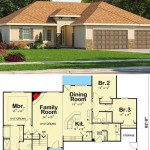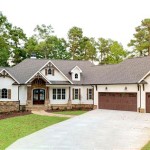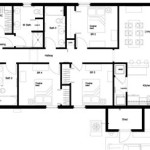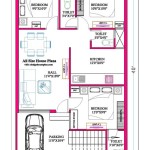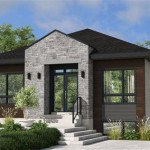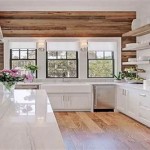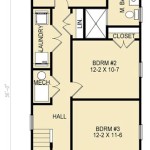Flat Roof Style Home Plans: Architecture, Design, and Considerations
Flat roof style home plans represent a distinct approach to residential architecture, characterized by roofs with minimal or no slope. These designs offer a modern aesthetic and can provide functional advantages, such as additional living space or the opportunity to install solar panels. However, careful planning and consideration are essential to ensure structural integrity, weather resistance, and long-term cost-effectiveness.
The allure of flat roof homes stems from their clean lines and geometric simplicity. This style is often associated with modern and contemporary architecture, enabling a streamlined appearance that integrates seamlessly into urban or minimalist landscapes. The absence of a pitched roof allows for a more efficient use of space, both inside and outside the home. This design can also contribute to energy efficiency by reducing the surface area exposed to direct sunlight.
The selection of appropriate materials and construction techniques is paramount when designing and building a flat roof home. The primary challenge is to prevent water accumulation and leakage, which can lead to significant structural damage. To this end, the roof must be designed with a slight slope (typically a quarter-inch per foot) to facilitate drainage. Furthermore, a robust waterproofing membrane is crucial to protect the underlying structure from moisture penetration.
Understanding the Key Advantages of Flat Roofs
Flat roof style home plans offer several key advantages, making them an appealing choice for certain homeowners and architectural projects. Beyond their aesthetic appeal, practical considerations often drive the decision to opt for a flat roof. These include cost-effectiveness in some cases, the potential for usable roof space, and simplified installation of equipment.
One of the primary advantages is cost savings in material usage. Compared to pitched roofs, flat roofs generally require less material to cover the same square footage. This can translate into reduced construction costs, especially for larger homes. The simplicity of the design also contributes to lower labor costs, as the construction process is often less complex than that of a traditional roof.
Usable roof space is another significant benefit of flat roof homes. The flat surface can be transformed into a patio, garden, or even an outdoor living area. This adds valuable square footage to the home and provides a unique space for recreation or relaxation. In urban environments, where land is scarce, this feature can be particularly attractive.
Flat roofs also simplify the installation of equipment, such as solar panels, HVAC systems, and skylights. The flat surface provides a stable and accessible platform for these installations, making maintenance and repairs easier. Solar panels, in particular, can be installed at an optimal angle to maximize energy production.
Essential Design Considerations for Flat Roof Homes
Designing a flat roof home requires meticulous attention to detail and a thorough understanding of the specific challenges associated with this architectural style. Several essential considerations must be addressed to ensure the long-term performance and durability of the roof. These include drainage, waterproofing, and insulation.
Effective drainage is critical to prevent water accumulation on the roof. Although the roof is described as "flat," it must have a slight slope to allow water to flow towards drains or scuppers. The drainage system should be designed to handle the maximum expected rainfall in the area, and regular maintenance is necessary to prevent clogging.
Waterproofing is another crucial aspect of flat roof design. A robust waterproofing membrane must be installed to protect the underlying structure from moisture penetration. Various types of membranes are available, including modified bitumen, EPDM rubber, and TPO. The choice of membrane will depend on factors such as climate, budget, and aesthetic preferences.
Insulation is essential for energy efficiency and to prevent condensation within the roof structure. Adequate insulation will help to maintain a consistent temperature inside the home and reduce energy consumption. Common insulation materials for flat roofs include rigid foam boards and spray foam.
Consideration should also be given to the weight-bearing capacity of the roof, particularly if it is intended to be used as a living space. The structure must be designed to support the weight of people, furniture, and any other objects that will be placed on the roof. A structural engineer should be consulted to ensure that the roof is adequately reinforced.
Material Choices and Construction Techniques for Flat Roofs
The selection of appropriate materials and construction techniques is critical to the success of a flat roof project. The materials must be durable, weather-resistant, and compatible with the overall design of the home. The construction techniques must be executed with precision to ensure a watertight and structurally sound roof.
Modified bitumen is a popular choice for flat roof membranes. It is a durable and relatively inexpensive material that is easy to install. Modified bitumen is typically applied in multiple layers, with each layer providing additional protection against water penetration. It is also resistant to UV degradation and can withstand extreme temperature fluctuations.
EPDM rubber is another common material for flat roof membranes. It is a synthetic rubber that is highly flexible and resistant to weathering. EPDM is typically installed in a single sheet, which minimizes the risk of leaks. It is also a sustainable material, as it can be recycled at the end of its lifespan.
TPO is a thermoplastic polyolefin membrane that is gaining popularity for flat roofs. It is a lightweight and energy-efficient material that is resistant to chemicals and UV radiation. TPO is heat-welded together, creating a seamless and watertight seal.
The construction of a flat roof typically involves several steps. First, a structural deck is installed to provide a solid base for the roof. This deck can be made of wood, concrete, or metal. Next, insulation is installed to improve energy efficiency. The waterproofing membrane is then applied over the insulation. Finally, a drainage system is installed to remove water from the roof.
Proper installation is crucial to the long-term performance of a flat roof. It is essential to hire a qualified contractor with experience in flat roof construction. The contractor should be familiar with the specific requirements of the chosen materials and construction techniques.
The design and construction of flat roof style home plans require careful planning and attention to detail. While these designs offer numerous advantages, including aesthetic appeal and functional space, it is crucial to address the potential challenges associated with water management and structural integrity. By selecting appropriate materials, employing proper construction techniques, and adhering to best practices, it is possible to create a durable, aesthetically pleasing, and energy-efficient flat roof home.

Modern Style House Plan 4 Beds 3 Baths 2142 Sq Ft 23 2310 Houseplans Com

Modern Flat Roof House Plans Pinoy Designs

Flat Roof House Design Bachelor Plan 1 Bedroom Low Cost

House Plans 10 7x10 5 With 2 Bedrooms Flat Roof 3d D16

Flat Roof House Design 38b

Modern 5 Bedroom Double Y House Id 25506 Plans By Maramani

Flat Roof House Design 3 Bedroom 19 2m X 16 1m Low Cost

Designing A Modern Flat Roof For Your Home Combit Construction

Modern House Plans 11x10 5 Flat Roof 2 Bedrooms Samhouseplans

Flat Roof House Plans South 4 Bedrooms Nethouseplans

